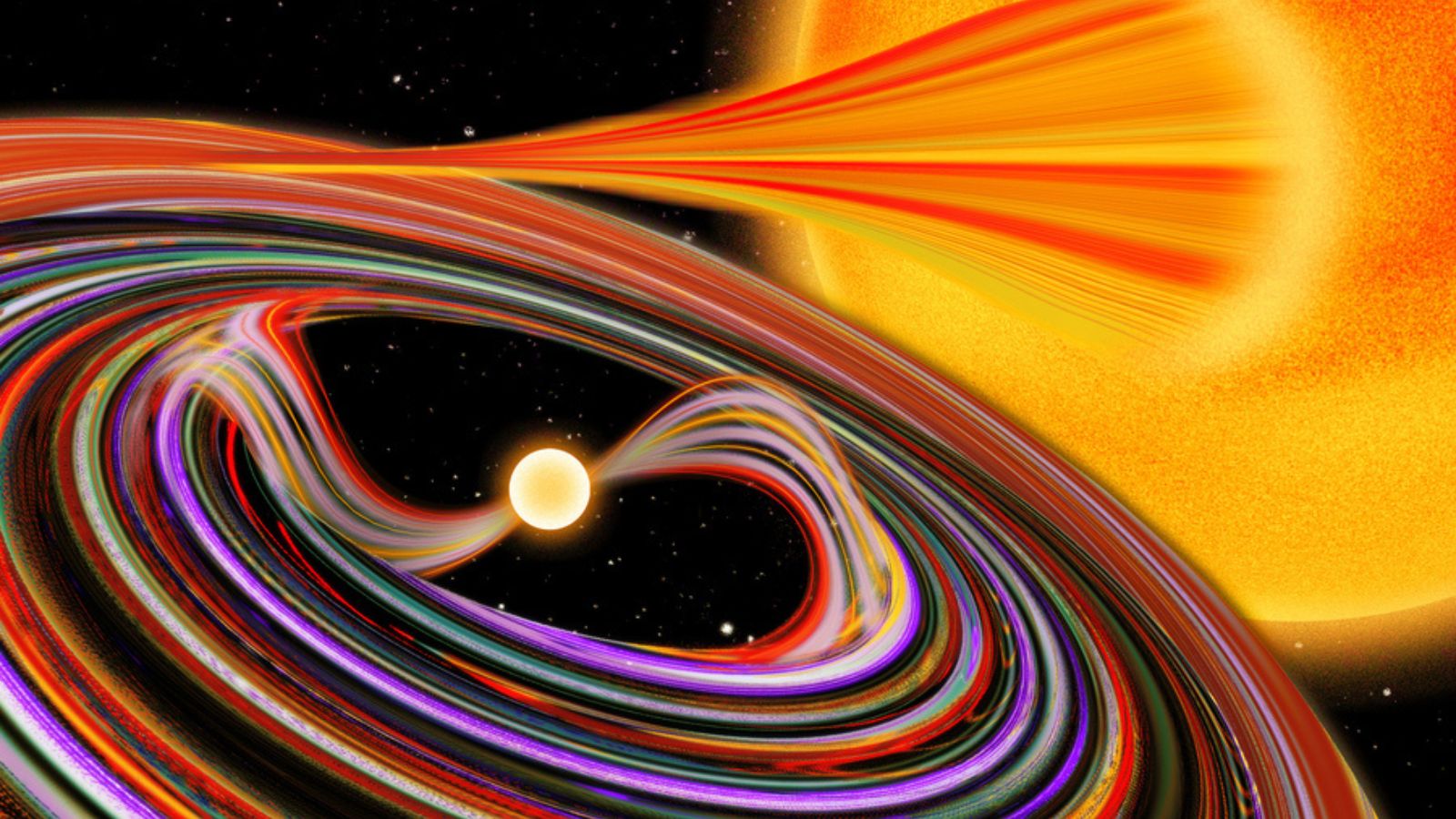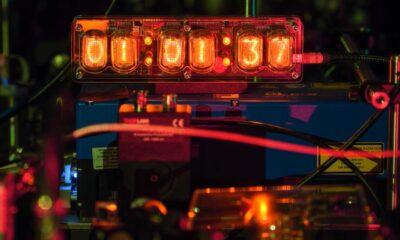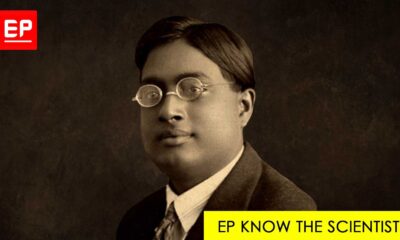Space & Physics
S N Bose – the world’s most underrated quantum maestro
There are plenty of scientists across the world from history, across the colonial era and beyond – which this ‘Know the Scientist’ page seeks to shed light on. It’s through us retelling these stories time and again do their experiences become immortalized in time for us to understand.

It’s 1924, and Satyendra Nath Bose, going by S.N. Bose was a young physicist teaching in Dhaka, then British India. Grappled by an epiphany, he was desperate to have his solution, fixing a logical inconsistency in Planck’s radiation law, get published. He had his eyes on the British Philosophical Magazine, since word could spread to the leading physicists of the time, most if not all in Europe. But the paper was rejected without any explanations offered.

But he wasn’t going to give up just yet. Unrelenting, he sent another sealed envelope with his draft and this time a cover letter again, to Europe. One can imagine months later, Bose breathing out a sigh of relief when he finally got a positive response – from none other than the great man of physics himself – Albert Einstein.
In some ways, Bose and Einstein were similar. Both had no PhDs when they wrote their treatises that brought them into limelight. And Einstein introduced E=mc2 derived from special relativity with little fanfare, so did Bose who didn’t secure a publisher with his groundbreaking work that invented quantum statistics. He produced a novel derivation of the Planck radiation law, from the first principles of quantum theory.
This was a well-known problem that had plagued physicists since Max Planck, the father of quantum physics himself. Einstein himself had struggled time and again, to only have never resolved the problem. But Bose did, and too nonchalantly with a simple derivation from first principles grounded in quantum theory. For those who know some quantum theory, I’m referring to Bose’s profound recognition that the Maxwell-Boltzmann distribution that holds true for ideal gasses, fails for quantum particles. A technical treatment of the problem would reveal that photons, that are particles of light with the same energy and polarization, are indistinguishable from each other, as a result of the Pauli exclusion principle and Heisenberg’s uncertainty principle.
Fascinatingly, this July will mark the 100 years since Einstein submitted Bose’s paper, “Planck’s law and the quantum hypothesis” on his behalf to Zeitschrift fur Physik.
Fascinated and moved by what he read, Einstein was magnanimous enough to have Bose’s paper translated in German and published in the journal, Zeitschrift für Physik in Germany the same year. It would be the beginning of a brief, but productive professional collaboration between the two theoretical physicists, that would just open the doors to the quantum world much wider. Fascinatingly, this July will mark the 100 years since Einstein submitted Bose’s paper, “Planck’s law and the quantum hypothesis” on his behalf to Zeitschrift fur Physik.
With the benefit of hindsight, Bose’s work was really nothing short of revolutionary for its time. However, a Nobel Committee member, the Swedish Oskar Klein – and theoretical physicist of repute – deemed it a mere advance in applied sciences, rather than a major conceptual advance. With hindsight again, it’s a known fact that Nobel Prizes are handed in for quantum jumps in technical advancements more than ever before. In fact, the 2001 Nobel Prize in Physics went to Carl Wieman, Eric Allin Cornell, and Wolfgang Ketterle for synthesizing the Bose-Einstein condensate, a prediction made actually by Einstein based on Bose’s new statistics. These condensates are created when atoms are cooled to near absolute zero temperature, thus attaining the quantum ground state. Atoms at this state possess some residual energy, or zero-point energy, marking a macroscopic phase transition much like a fourth state of matter in its own right.
Such were the changing times that Bose’s work received much attention gradually. To Bose himself, he was fine without a Nobel, saying, “I have got all the recognition I deserve”. A modest character and gentleman, he resonates a lot with the mental image of a scientist who’s a servant to the scientific discipline itself.
He was awarded the Padma Vibhushan, the highest civilian award by the Government of India in 1954. Institutes have been named in his honour, but despite this, his reputation has little if no mention at all in public discourse.
But what’s more upsetting is that, Bose is still a bit of a stranger in India, where he was born and lived. He studied physics at the Presidency College, Calcutta under the tutelage that saw other great Indian physicists, including Jagdish Chandra Bose and Meghnad Saha. He was awarded the Padma Vibhushan, the highest civilian award by the Government of India in 1954. Institutes have been named in his honour, but despite this, his reputation has little if no mention at all in public discourse.
To his physicists’ peers in his generation and beyond, he was recognized in scientific lexicology. Paul Dirac, the British physicist coined the name ‘bosons’ in Bose’s honor (‘bose-on’). These refer to quantum particles including photons and others with integer quantum spins, a formulation that arose only because of Bose’s invention of quantum statistics. In fact, the media popular, ‘god particle’, the Higgs boson, carries a bit of Bose as much as it does of Peter Higgs who shared the 2013 Nobel Prize in Physics with Francois Englert for producing the hypothesis.
There are plenty of scientists across the world from history, across the colonial era and beyond – which this ‘Know the Scientist’ page seeks to shed light on. It’s through us retelling these stories time and again do their experiences become immortalized in time for us to understand.
Space & Physics
A Zombie Star 200 Light Years Away Is Feeding — and MIT Saw the X-Rays
New observations reveal a towering column of superheated gas and confirm long-suspected features of a rare “intermediate polar” system.

Far beyond the reach of visible light, a faint stellar remnant about 200 light years from Earth is undergoing a dramatic and violent process. Astronomers have long known that the object — a white dwarf locked in orbit with a larger star — pulls material from its companion in intense bursts. But until now, the inner region where this activity peaks has largely remained hidden.
A new study led by MIT researchers has uncovered the clearest picture yet of this turbulent zone. Using NASA’s Imaging X-ray Polarimetry Explorer (IXPE), the team has mapped the polarized X-ray signals emitted by EX Hydrae, a rare “intermediate polar” star system. Their results, published in the Astrophysical Journal, provide the first direct evidence of the extreme geometry near the white dwarf’s surface.
The observations revealed an unexpectedly strong level of X-ray polarization — far higher than predicted — allowing scientists to pinpoint the exact region where the radiation originates. According to the team, the X-rays come from a column of superheated gas being funneled onto the white dwarf’s magnetic poles.
In a media statement, lead author Sean Gunderson said, “We showed that X-ray polarimetry can be used to make detailed measurements of the white dwarf’s accretion geometry. It opens the window into the possibility of making similar measurements of other types of accreting white dwarfs that also have never had predicted X-ray polarization signals.”
A 2,000-mile tower of white-hot material
The IXPE measurements indicate that this column is far larger than previously thought — roughly 2,000 miles tall, nearly half the size of the white dwarf itself. Standing near the magnetic pole, Gunderson said, one would see “a column of gas stretching 2,000 miles into the sky, and then fanning outward.”
This monstrous structure forms where material from the larger star is lifted by the white dwarf’s magnetic field before plunging down at millions of miles per hour. The resulting collisions heat the gas to tens of millions of degrees, generating intense X-rays.
Reflected X-rays reveal the system’s hidden architecture
The team also detected the direction of the polarized X-rays, showing that the radiation was bouncing off the white dwarf’s surface before reaching IXPE. This long-suspected reflection effect had never been observed directly.
MIT graduate student Swati Ravi said in a statement, “The thing that’s helpful about X-ray polarization is that it’s giving you a picture of the innermost, most energetic portion of this entire system. When we look through other telescopes, we don’t see any of this detail.”
A new use for IXPE — and new clues about supernova origins
Although IXPE has previously focused on black holes, neutron stars and supernova remnants, this is the mission’s first detailed observation of an intermediate polar — a smaller but highly energetic type of system.
Co-author Herman Marshall said, “We started talking about how much polarization would be useful to get an idea of what’s happening in these types of systems, which most telescopes see as just a dot in their field of view.”
Understanding how white dwarfs accumulate matter is not just an academic exercise. In extreme cases, the inflow becomes so great that the white dwarf collapses into a powerful supernova — a cosmic explosion used to measure the scale of the universe.
Marshall added, “Understanding these white dwarf systems helps scientists understand the sources of those supernovae, and tells you about the ecology of the galaxy.”
The team now plans to extend X-ray polarization studies to other accreting white dwarfs, hoping to map the early stages of processes that eventually lead to some of the universe’s most important explosions.
Space & Physics
MIT Pioneers Real-Time Observation of Unconventional Superconductivity in Magic-Angle Graphene
Physicists have directly observed unconventional superconductivity in magic-angle twisted tri-layer graphene using a new experimental platform, revealing a unique pairing mechanism

MIT physicists have unveiled compelling direct evidence for unconventional superconductivity in “magic-angle” twisted tri-layer graphene—an atomically engineered material that could reimagine the future of energy transport and quantum technologies. Their new experiment marks a pivotal step forward, offering a fresh perspective on how electrons synchronize in precisely stacked two-dimensional materials, potentially laying the groundwork for next-generation superconductors that function well above current temperature limits.
Instead of looking merely at theoretical possibilities, the MIT team built a novel platform that lets researchers visualize the superconducting gap “as it emerges in real-time within 2D materials,” said co-lead author Shuwen Sun in a media statement. This gap is crucial, reflecting how robust the material’s superconducting state is during temperature changes—a key indicator for practical applications.
What’s striking, said Jeong Min Park, study co-lead author, is that the superconducting gap in magic-angle graphene differs starkly from the smooth, uniform profile seen in conventional superconductors. “We observed a V-shaped gap that reveals an entirely new pairing mechanism—possibly driven by the electrons themselves, rather than crystal vibrations,” Park said. Such direct measurement is a “first” for the field, giving scientists a more refined tool for identifying and understanding unconventional superconductivity.
Senior author Pablo Jarillo-Herrero emphasized that their method could help crack the code behind room-temperature superconductors: “This breakthrough may trigger deeper insights not just for graphene, but for the entire class of twistronic materials. Imagine grids and quantum computers that operate with zero energy loss—this is the holy grail we’re moving toward,” Jarillo-Herrero said in the MIT release.
Collaborators included scientists from Japan’s National Institute for Materials Science, broadening the impact of the research. The discovery builds on years of progress since the first magic-angle graphene experiments in 2018, opening what many now call the “twistronics” era—a field driven by stacking and twisting atom-thin materials to unlock uniquely quantum properties.
Looking ahead, the team plans to expand its analysis to other ultra-thin structures, hoping to map out electronic behavior not only for superconductors, but for a wider range of correlated quantum phases. “We can now directly observe electron pairs compete and coexist with other quantum states—this could allow us to design new materials from the ground up,” said Park in her public statement.
The research underscores the value of visualization in fundamental physics, suggesting that direct observation may be the missing link to controlling quantum phenomena for efficient, room-temperature technology.
Space & Physics
Atoms Speak Out: Physicists Use Electrons as Messengers to Unlock Secrets of the Nucleus
Physicists at MIT have devised a table-top method to peer inside an atom’s nucleus using the atom’s own electrons

Physicists at MIT have developed a pioneering method to look inside an atom’s nucleus — using the atom’s own electrons as tiny messengers within molecules rather than massive particle accelerators.
In a study published in science, the researchers demonstrated this approach using molecules of radium monofluoride, which pair a radioactive radium atom with a fluoride atom. The molecules act like miniature laboratories where electrons naturally experience extremely strong electric fields. Under these conditions, some electrons briefly penetrate the radium nucleus, interacting directly with protons and neutrons inside. This rare intrusion leaves behind a measurable energy shift, allowing scientists to infer details about the nucleus’ internal structure.
The team observed that these energy shifts, though minute — about one millionth of the energy of a laser photon — provide unambiguous evidence of interactions occurring inside the nucleus rather than outside it. “We now have proof that we can sample inside the nucleus,” said Ronald Fernando Garcia Ruiz, the Thomas A. Franck Associate Professor of Physics at MIT, in a statement. “It’s like being able to measure a battery’s electric field. People can measure its field outside, but to measure inside the battery is far more challenging. And that’s what we can do now.”
Traditionally, exploring nuclear interiors required kilometer-long particle accelerators to smash high-speed beams of electrons into targets. The MIT technique, by contrast, achieves similar insight with a table-top molecular setup. It makes use of the molecule’s natural electric environment to magnify these subtle interactions.
The radium nucleus, unlike most which are spherical, has an asymmetric “pear” shape that makes it a powerful system for studying violations of fundamental physical symmetries — phenomena that could help explain why the universe contains far more matter than antimatter. “The radium nucleus is predicted to be an amplifier of this symmetry breaking, because its nucleus is asymmetric in charge and mass, which is quite unusual,” Garcia Ruiz explained.
To conduct their experiments, the researchers produced radium monofluoride molecules at CERN’s Collinear Resonance Ionization Spectroscopy (CRIS) facility, trapped and cooled them in laser-guided chambers, and then measured laser-induced energy transitions with extreme precision. The work involved MIT physicists Shane Wilkins, Silviu-Marian Udrescu, and Alex Brinson, alongside international collaborators.
“Radium is naturally radioactive, with a short lifetime, and we can currently only produce radium monofluoride molecules in tiny quantities,” said Wilkins. “We therefore need incredibly sensitive techniques to be able to measure them.”
As Udrescu added, “When you put this radioactive atom inside of a molecule, the internal electric field that its electrons experience is orders of magnitude larger compared to the fields we can produce and apply in a lab. In a way, the molecule acts like a giant particle collider and gives us a better chance to probe the radium’s nucleus.”
Going forward, the MIT team aims to cool and align these molecules so that the orientation of their pear-shaped nuclei can be controlled for even more detailed mapping. “Radium-containing molecules are predicted to be exceptionally sensitive systems in which to search for violations of the fundamental symmetries of nature,” Garcia Ruiz said. “We now have a way to carry out that search”
-

 Know The Scientist6 months ago
Know The Scientist6 months agoRemembering S.N. Bose, the underrated maestro in quantum physics
-

 Space & Physics4 months ago
Space & Physics4 months agoJoint NASA-ISRO radar satellite is the most powerful built to date
-

 Society5 months ago
Society5 months agoShukla is now India’s first astronaut in decades to visit outer space
-

 Space & Physics4 months ago
Space & Physics4 months agoNew double-slit experiment proves Einstein’s predictions were off the mark
-

 Society6 months ago
Society6 months agoAxiom-4 will see an Indian astronaut depart for outer space after 41 years
-

 The Sciences5 months ago
The Sciences5 months agoHow a Human-Inspired Algorithm Is Revolutionizing Machine Repair Models in the Wake of Global Disruptions
-

 Society6 months ago
Society6 months agoWhy the Arts Matter As Much As Science or Math
-

 Earth6 months ago
Earth6 months agoWorld Environment Day 2025: “Beating plastic pollution”






































